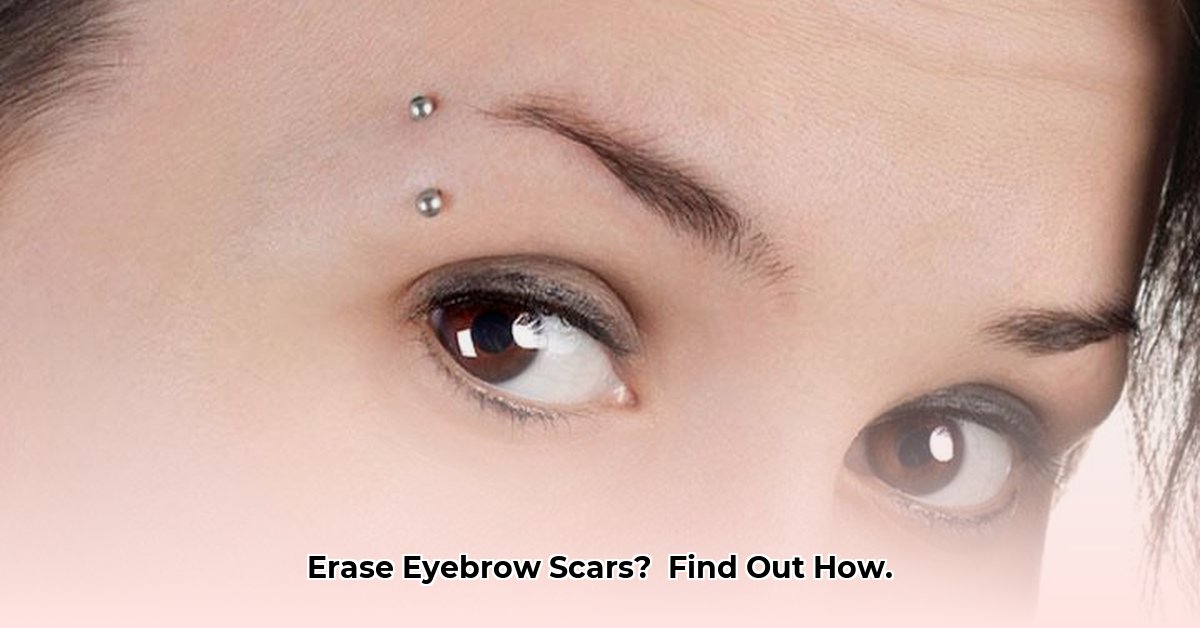Let’s face it, eyebrow scars can impact your self-esteem and overall appearance. But you’re not alone, and effective treatments are available. For information on insurance coverage, check out this helpful guide on insurance coverage. This guide explores understanding eyebrow scars and finding the best treatment for you, from microblading to surgical procedures, ensuring you make an informed decision.
Understanding Eyebrow Scars and Treatment Options
Dealing with an eyebrow scar can be a source of frustration, affecting both your appearance and self-confidence. Fortunately, various approaches can address this, ranging from simple camouflage to more advanced medical interventions. This guide aims to help you understand your specific scar and navigate the most effective treatment pathway for your individual needs.
Identifying Your Eyebrow Scar Type: A Crucial First Step
Eyebrow scars vary significantly. Some are small and barely noticeable, while others are more prominent, altering eyebrow shape or causing hair loss. The type of scar—raised (hypertrophic), sunken (atrophic), or excessively thick (keloid)—determines the most suitable treatment. A dermatologist’s evaluation is essential to assess the scar’s depth, texture, and characteristics, forming the basis of a personalized treatment plan. Understanding the distinct characteristics of each scar type allows for more targeted treatment. Hypertrophic scars, for example, are often red and raised, responding well to treatments aimed at reducing inflammation and collagen production. Atrophic scars, conversely, require methods that stimulate collagen and elastin to fill in the depressed area. Keloid scars, known for their aggressive growth, often necessitate a multi-faceted approach, including surgical removal followed by therapies to prevent recurrence.
Exploring Treatment Options for Different Scar Severities
Various treatment options cater to different types and severities of eyebrow scars. The following choices offer distinct benefits and drawbacks:
Minimally Invasive Procedures for Minor Scars:
For smaller, less noticeable scars, microblading and cosmetic tattooing can effectively mask the scar by recreating the appearance of eyebrow hairs using specialized pigments. These techniques offer a form of semi-permanent makeup, typically requiring touch-ups annually to maintain a fresh look. Microblading involves using a fine blade to create tiny incisions in the skin, depositing pigment to mimic individual hair strokes. Cosmetic tattooing, on the other hand, uses a machine to implant pigment deeper into the skin, resulting in a more solid fill. The choice between the two depends on the desired look and the scar’s characteristics.
Advanced Treatments for Significant Scars:
Surgical scar revision may be necessary for deeper, wider scars that significantly disrupt the eyebrow’s natural shape. This procedure aims to improve the scar’s appearance by removing scar tissue and reshaping the surrounding skin. Techniques like Z-plasty or W-plasty can be used to reorient the scar along natural skin lines, making it less noticeable. Hair transplantation involves grafting hair follicles to the scarred area, restoring hair growth. Follicular Unit Extraction (FUE) and Follicular Unit Transplantation (FUT) are common methods, with FUE being less invasive and leaving minimal scarring at the donor site.
Laser therapy, specifically fractional lasers, can also improve the texture and appearance of scars by stimulating collagen production and remodeling the scar tissue. Multiple sessions are typically required to achieve optimal results.
Here’s a summary of the benefits and drawbacks of these treatments:
| Treatment Method | Pros | Cons |
|---|---|---|
| Microblading/Tattooing | Relatively quick; minimal downtime; camouflages imperfections effectively. | Not permanent; needs touch-ups; might not work for all scar types; potential for allergic reactions. |
| Surgical Scar Revision | Can significantly improve scar appearance; potentially a more permanent solution. | Invasive; longer recovery; potential for complications like infection or unsatisfactory cosmetic results; more expensive |
| Hair Transplantation | Permanent hair restoration; natural-looking results for hair loss from scarring. | Invasive; costly; multiple sessions may be needed; results can vary; longer downtime. |
| Topical Treatments | Non-invasive; may encourage hair growth. | Effectiveness varies greatly; limited long-term studies available. |
| Laser Therapy | Non-invasive; improves scar texture and appearance. | Multiple sessions; may cause temporary redness or swelling; not suitable for all skin types. |
The Role of Camouflage and Makeup for Temporary Improvement
Before considering extensive procedures, makeup can effectively conceal eyebrow scars temporarily. Concealers and eyebrow pencils can help achieve the desired look, with numerous online tutorials available to guide you. Opting for waterproof and smudge-proof products ensures long-lasting coverage, especially in humid conditions or during physical activity. Experimenting with different application techniques, such as stippling or layering, can help achieve a more natural look.
Choosing the Right Eyebrow Restoration Path for Your Needs
Selecting the best treatment involves considering scar severity, aesthetic goals, budget, and overall health. Consulting a dermatologist or plastic surgeon is invaluable in weighing the pros and cons of each treatment, discussing potential risks, and developing a personalized plan. This collaborative approach ensures your concerns and goals are central to the process. During the consultation, be prepared to discuss your medical history, any previous scar treatments, and your expectations for the outcome. The doctor will examine your scar, take measurements, and may order additional tests to assess its characteristics.
Understanding Potential Risks and Complications
No medical procedure is entirely risk-free. Surgical techniques carry risks of infection, excessive scarring, or unsatisfactory results. Minimally invasive options like microblading and tattooing can trigger allergic reactions. Open communication with your doctor is essential to address concerns and understand potential risks. Before undergoing any procedure, ask about the doctor’s experience and qualifications, the potential side effects, and the steps you can take to minimize complications.
A Step-by-Step Guide to Regaining Confidence
Treating an eyebrow scar involves a multi-step process:
- Consultation is Key: Schedule a thorough evaluation with a qualified dermatologist or plastic surgeon to start with a foundational step.
- Understand Your Scar: Learn about the type, size, and depth of your scar to inform treatment decisions.
- Explore Treatments: Research available options and discuss their suitability with your healthcare provider.
- Choose Your Approach: Select the treatment that aligns with your needs and expectations.
- Follow Instructions: Adhere to your doctor’s instructions diligently during and after the procedure.
- Recovery & Follow-Up: Attend all post-treatment appointments for monitoring and support to ensure optimal healing.
Treating an eyebrow scar requires patience, and consistent follow-up care is essential for achieving the best possible outcome. Maintaining realistic expectations and celebrating progress can significantly affect your journey. Documenting your progress with before-and-after photos can help you track your results and stay motivated.
How to Choose the Best Eyebrow Scar Treatment Based on Scar Type
Key Takeaways:
- Treatment choices significantly depend on the scar’s type, size, and age.
- Minor scars might only need cosmetic camouflage.
- More serious scars may require surgical intervention.
- Choosing the right treatment is a collaborative process with your doctor.
- Realistic expectations are key to a positive outcome.
Understanding Your Scar Type: The Foundation of Effective Treatment
Before exploring treatments, understanding your scar type is crucial, as different scars respond differently to various therapies. A dermatologist can accurately classify your scars, whether they are raised and red (hypertrophic), sunken and pale (atrophic), or keloid scars that grow beyond the original wound boundary. Hypertrophic scars, arising from an overproduction of collagen during healing, often benefit from treatments that reduce inflammation and collagen synthesis, such as corticosteroid injections or silicone sheeting. Atrophic scars, resulting from tissue loss, may require procedures that stimulate collagen production, like microneedling or laser resurfacing. Keloid scars, known for their aggressive growth beyond the original wound site, often necessitate a combination of treatments, including surgical excision, radiation therapy, and corticosteroid injections.
Treatment Options: Tailoring the Approach to Your Scar
Several options exist, each with its own strengths and weaknesses:
- Makeup Camouflage: Offers a quick, inexpensive, and temporary fix, ideal for minor scars. It provides immediate improvement and involves using specialized makeup to blend the scar into your skin. High-pigment concealers and color-correcting primers can effectively neutralize discoloration and create a smooth canvas.
- Microblading: This semi-permanent procedure is ideal for filling in sparse or missing eyebrow hairs. It’s effective for camouflaging minor scars and adding definition. However, it’s not a cure for the scar itself. Microblading works best on scars that are relatively flat and have minimal texture.
- Surgical Scar Revision: Might be necessary for more significant scars to reshape, reduce, or remove the scar tissue. Techniques like Z-plasty and W-plasty can help reorient the scar along natural skin lines, making it less noticeable.
- Hair Transplantation: Suitable for patients with hair loss in the eyebrow area due to scarring. The success largely depends on donor hair availability and the surgical team’s expertise. Follicular Unit Extraction (FUE) and Follicular Unit Transplantation (FUT) are common methods, with FUE being less invasive and leaving minimal scarring at the donor site.
- Topical Treatments: Over-the-counter or prescription creams and ointments containing ingredients like silicone, onion extract, or vitamin E can help improve the appearance of scars over time.
- Laser Therapy: Different types of lasers can be used to improve the texture
- The Best Bento Box Price For Your Perfect Packed Lunch - December 15, 2025
- Bento Box Shopping Tips for Smart and Stylish Lunch Prep - December 14, 2025
- Bento Box Trays Streamline Restaurant Meal Presentation and Transport - December 13, 2025










